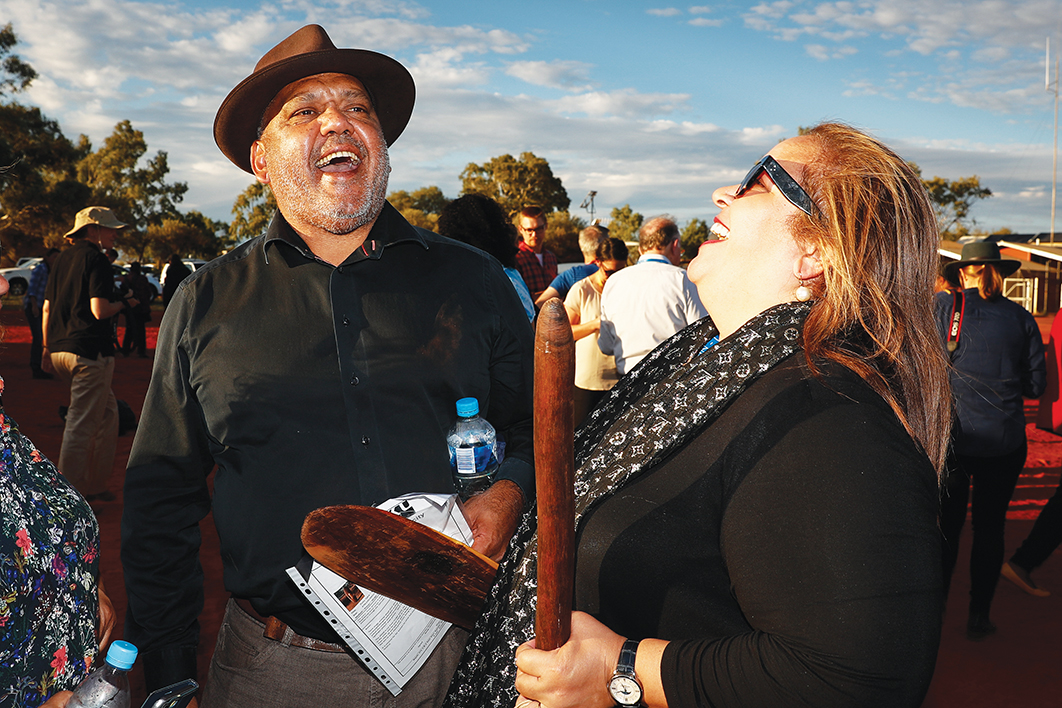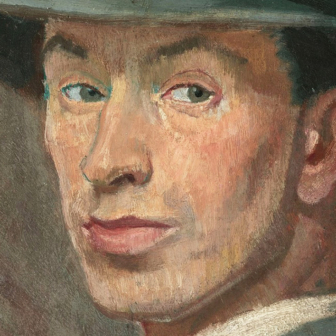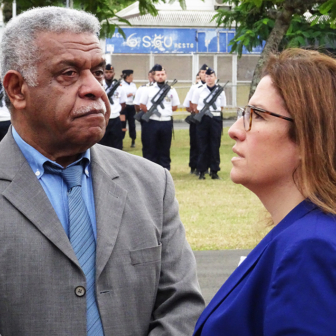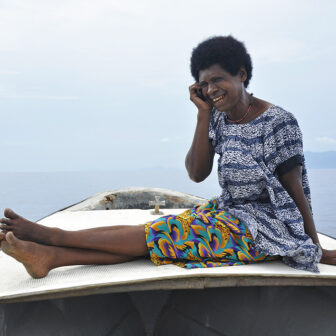Noel Pearson believes in human plasticity: people can and should remake themselves. Indeed, his intensely autobiographical style means that he himself is a vivid example of the human capacity for reflection, revision and renewal. In the fifty-seven articles, essays and speeches gathered in his new book, Mission — twenty-eight of which appeared in the Australian between 1987 and 2021 — we catch many glimpses of Pearson’s self-reinvention.
Pearson can be witheringly self-critical, publicly regretting positions he once took. But his writing is also shaped by continuities. He continues to disdain identity politics and to highlight the limits of using white racism as an all-embracing explanation for First Nations’ suffering. He worries that we don’t pay enough attention to class differences. He argues that each person has several identities, each contextually relevant.
He also thinks that multiculturalism must not be allowed to degenerate into “plural monoculturalism” — as if Australian are defined solely by ethnicity — because “identity fundamentalism is the enemy of the commonwealth.” This injunction to pluralise oneself for the sake of forging multiple allegiances is embedded in his belief that people have the power to make themselves up.
Sometimes people do this gullibly, he thinks, by uncritically internalising others’ accounts of them. In Mission’s oldest item — a 1987 paper co-written with Hope Vale Aboriginal community’s Merv Gibson — he warned Indigenous Australians against chaining themselves to others’ accounts of their beliefs and behaviour. In particular, he and Gibson suggested that too many Aboriginal people have embraced anthropologists’ accounts of their resistance. “Alcoholism and social irresponsibility” have become “associated with Aboriginal identity.” Aboriginal people have come to think that “achievement and social responsibility are the preserve of white people.”
Pearson often comes back to this idea that his people have uncritically internalised others’ versions of them. He gives the example of First Nations people accepting distinctions such as “moderate or radical, conservative or activist.” He is wary of the seductions of the word “community.” Insofar as First Nations people who reside in “communities” adopt the “fantasies of communitarianism,” they fail to see how weak and ineffective their informal solidarity has become.
What worries Pearson perhaps the most is that many Aboriginal people have come to believe themselves to be environmentalists. Conceding much of the Indigenous land and sea estate to the national project of protecting Australia’s biological diversity (in the Indigenous Protected Areas), they have effectively endorsed a “green terra nullius” promoted by a nature-loving politics.
Pearson’s conviction that personhood and culture are emergent and negotiable is consistent with the narrative turn in the social sciences: the argument that what people think and do is bound up with the stories they believe about themselves. From this insight, it follows that histories and labels are formative rather than merely descriptive. Pearson studied history at the University of Sydney in the mid 1980s, when historians were pushing stories of British invasion and Aboriginal resistance to the centre of the national narrative.
Pearson has reservations about how “black armband history” (as Geoffrey Blainey would label it) encourages certain Black identities. Revisionist history offered Aboriginal people “the language of victim politics,” he writes. While it “positioned the rest of Australia as guilty perpetrators,” it disempowered Aboriginal people. Kevin Rudd’s 2008 apology to the stolen generations risked cementing “a detrimental psychology of victimhood.” Discussing the public response to the Bringing Them Home report, he observes that problems arise “when history as a discipline meets history as popular culture.”
Throughout Mission, we see Pearson continuing to digest his own experience of Hope Vale mission community as he seeks “a clear understanding of the good and bad in the past.” Against a “guilty perpetrators” story of the colonisation of Australia, Pearson has stressed Australian society’s demonstrated capacity for accommodating Indigenous Australia. It would be “dumb” Aboriginal politics, he argued in his 1993 Boyer lecture, not to make use of conceded rights or to ignore employment and educational opportunities. He doesn’t want the revised account of Australian history to encourage Indigenous identities of radical alterity, dedicated unrespectability and helplessness.
Negotiating native title in 1993 confirmed to Pearson that Australia is capable of accommodating a workable version of Indigenous rights. In speeches in 1994 and 1996, “cornerstone” was his metaphor for the High Court’s Mabo judgement. He credited the 1993 Native Title Act to the Keating government’s “inclusive leadership” — “an act of political decency” defying racist backlash. In articles not included in Mission he also criticised the limits set on First Nations property rights by native title determinations.
Having found a voice and national prominence under Labor, Pearson was forced to reposition himself during the four terms of Coalition government between 1996 and 2007. At first, his message was mixed. In 1997 he publicly retracted his warning that the Coalition was cultivating white resentment. When Howard began to persuade conservatives that Australia could accommodate native title as long as the legislation was substantially amended, Pearson reminded Liberals that their ideological principles included the rule of law and the defence of property against arbitrary seizure. He accused Howard of lying to justify “annihilating” amendments.
Howard’s legislation secured native title against conservative repeal. Pearson then redirected his attention from external threats to Indigenous rights towards threats — from within — to Indigenous capacities. Cape York society worried him. Typical of his historical approach, his analysis of First Nations’ malaise rested on his recasting of the nation’s history. In “Our Right to Take Responsibility” (2000) he periodised Australia’s colonial history in a way that better fitted communities like Hope Vale.
Pearson emphasised that Aboriginal people adapted after invasion, finding places in the new regional economies managed paternalistically by missionaries and pastoralists. During its time as a Lutheran mission, Hope Vale’s paternalism was not humiliating; rather, it created a new sense of community among those removed to it, and secured residents from the outside world’s humiliations.
This modus vivendi was subverted around 1970 when Aboriginal people became eligible for welfare. “After we became citizens with equal rights and equal pay, we lost our place in the real economy.” Possibly the most influential sentence Pearson will ever write, this encapsulated two important ideas. The first was that — contrary to progressive historical narrative — citizenship can have dire unintended consequences.
The second lay in the phrase “the real economy.” Pearson evoked it as a forfeited moral and psychological condition rather than a defined structure of institutions. What characterised a “real economy” was its moral structure: it rewarded those who took on the “responsibility” to support kin and it required “reciprocity,” with effort earning material support. The welfare regime on Cape York was not a “real economy,” Pearson claimed, and it was vital, “if we are to survive as a people,” to replace it with one. “The Hope Vale of today is socially and culturally weaker than the Hope Vale of my father’s day,” he lamented in 2014.
What measures would recover that old strength? With the take-up of the phrase “real economy” by policymakers, Pearson found himself aligned with a series of policy changes that set tougher conditions on the income support received individually or collectively by Indigenous Australians. In particular, Pearson’s distinction between “real” and “gammon” economies helped set the scene for extinguishing the Community Development Employment Projects scheme, or CDEP, from 2007.
The scheme had been necessary because remote Indigenous Australians are land-rich in regions that have long been capital-poor. By 1970 it was apparent that there would continue to be more Aboriginal people of working age in remote regions than there were jobs. By 1975, when the most remote Aboriginal people were declared eligible for unemployment benefits, the Australian government faced a crisis of labour excess.
The Fraser government’s solution was CDEP: from 1977 communities could apply to access individual unemployment benefits as a lump sum, topped up with a grant, and so become local employers, soaking up the excess of working-age Aboriginal people and — potentially — doing work that was meaningful to those employed and valued by the community.
Pearson didn’t explicitly denounce CDEP in 2000, but his description of the “passive welfare paradigm” implicitly included it. “The economy of the communities,” he wrote, “is artificially sustained by government funds.” For policymakers who had been debating whether to extend, cut back or abolish CDEP, this seemed to depict the scheme as a problem rather than a solution. As an “artifice” it could not be an institution of the “real economy,” so it must be a part of the “passive welfare paradigm.”
The long opening essay in Mission brings the news that Pearson has now repudiated that confident demarcation of public/artificial from private/real. Building on articles in the Australian in July 2020, he is calling for a “universal job guarantee” to “ensure all citizens wanting work have the opportunity, through public programs.” He admits that he used to dismiss “universal job guarantee” as a socialist demand: “We looked to the private sector to generate these jobs.” Now he sees complementary public sector employment as essential.
Pearson explains that he has observed the Morrison government’s subsidising of employers’ demand for labour during the pandemic, and he has also been reading Modern Monetary Theory. Practice and theory have combined to overturn his understanding of what a welfare-to-work program can do. If it is fiscally sound for governments to fund employment by going into debt, he reasons, then why don’t governments always create demand for labour wherever and whenever it is lacking?
This call could not be more timely, as the Australian government has recently abandoned a disastrous “welfare-to-work” experiment involving people living in remote regions. The Community Development Program, or CDP, was launched by the Abbott government on 1 July 2015; its termination (scheduled for 2023) was announced by the Coalition’s Indigenous Australians minister Ken Wyatt in May this year. A recent Australia Institute study shows how “CDP” effectively stood for Continuing Delinquency and Poverty: it tested working-age adults against a demanding standard of job-seeker motivation, failed them, and so plunged more households into poverty. Four out of five of CDP’s 40,000-odd clients are Indigenous.
Having recently modified CDP’s mutual obligation requirements, the Morrison government is calling for submissions on the design of a replacement scheme, to be launched in 2023. The Australia Institute’s Remote Access report outlines the principles to which a remote “welfare-to-work” scheme should adhere, and in a recent ANU seminar the authors judged Pearson’s ideas to be consistent, in most respects, with those principles. An Australian government taking advice from the Noel Pearson of 2021 would be heading in a progressive direction.
But “Our Right to Take Responsibility” had wider effects in the early 2000s than helping to put the skids under CDEP. Pearson invited champions of Indigenous rights to acknowledge that the evolved culture of some Indigenous Australians was disabling them. His essay offered progressive Australians release from a thought trap in which support for “self-determination” in principle had blocked unsentimental scrutiny of its practice.
Giving the Australian public permission to discuss “Indigenous dysfunction,” Pearson targeted what he saw as progressive shibboleths. His Ben Chifley Memorial Lecture (2000) warned that progressive thought — the work of “academics, bureaucrats and parliamentarians who became the intellectual trustees of the welfare state” — had fallen into “confusion.” Aboriginal Legal Aid, for example, was “part of the criminal justice industry… a sausage machine,” when “the real need is for the restoration of social order.”
Pearson urged us to cease explaining Aboriginal alcohol and drug abuse as the effect of “trauma, transgenerational grief, racism, dispossession, unemployment and poverty.” Questioning the Royal Commission into Aboriginal Deaths in Custody’s reference to these as “underlying issues,” he argued that while these factors made addiction more likely, it is better conceived as a problem in its own right. He called for addictions to be mitigated by working on five factors that enable them: supply, spare time, disposable income, peer pressure and “permissive social ideology.” “Enforced treatment” was necessary, he argued.
Denying that he had shifted to the right, Pearson decried Labor’s unwillingness to use the phrase “welfare dependency” and welcomed non-Labor’s pragmatic openness “to dialogue about our immediate problems.” By failing to discuss individual responsibility, he said, the left was part of the apparatus of oppression. Against progressives’ libertarianism he invoked Amartya Sen in order to demand that social policy provide individuals with the capacities — not only income but “health, education and community life” — to make choices. This would require “more external expenditure, not less.”
The Australian (lavishly praised by Pearson on its fiftieth birthday) began to publish his essays criticising what he saw as the delusions and bad faith of “progressive” opinion. He presented his ideal: bicultural “orbiting.” First Nations people can and should become adept in both the remote Aboriginal community and the wider Australian society. Where should remote Indigenous children go to secondary school? Pearson encouraged attendance at distant boarding schools (his own experience), while not dismissing the possibility that public investment could bring quality to high schools in regional centres. The progressive shibboleth of “culturally appropriate” schooling, he told Queensland premier Anna Bligh, had become “an alibi for anti-intellectualism.”
The longest reprinted piece in Mission is “Radical Hope” (2009), in which Pearson argued for a prescriptive preschool and primary curriculum (“direct instruction”) to offset the uneven quality of teachers prepared to work in remote regions. In 2011 he explained that he sought “Aboriginal Australians’ internalisation of the Enlightenment” while they continue using their mother tongue. The survival of their languages, he says, is “solace” for their grief over lost sovereignty.
By the time Pearson began highlighting the significance of language to peoplehood he was not only reporting on his Cape York Partnership’s academic experiments but also helping an expert panel (appointed by Julia Gillard in December 2010) to draft amendments to the Australian Constitution. The panel urged that constitutional recognition include recognising that “the Aboriginal and Torres Strait Islander languages are the original Australian languages, a part of our national heritage.”
Although he later (2016) claimed to be “the principal advocate of this proposal,” Pearson was soon advising Australians to give up on the expert panel’s entire package of amendments — not only the constitutional recognition of languages but also more contentious proposals to make it constitutionally invalid to legislate against Indigenous interests or to discriminate against any “race.” Why did Pearson ditch the panel’s embattled package?
Pearson first publicly considered this change in “A Rightful Place” (2014), in which he explained why conservatives did not like the panel’s proposals to amend the Constitution to prohibit racial discrimination and to secure the advancement of Aboriginal and Torres Strait Islander peoples. For the previous two and a half years, constitutional conservatives had been warning that the amendments would encourage Indigenous Australians to litigate in the High Court against laws that were not in their favour. Empowering the High Court in relation to legislators was anathema to constitutional conservatives’ “strong aversion to activist judges.”
To conciliate these critics (who published frequently in the Australian) Pearson offered a two-pronged alternative. A new federal head of power to legislate on “Indigenous people” need not proscribe laws considered “negative” by First Nations. Instead, they would get “a fair say in laws and policies about us” through a new constitutionally enshrined body, the Indigenous Voice to Parliament. By making this manoeuvre Pearson was enacting a concept that he had first propounded in 2005: the “radical centre” that “challenges the vested political interests of both left and right.”
By May 2017 Pearson had persuaded a series of assemblies of Indigenous Australians — climaxing in the Uluru Statement from the Heart — that the Voice should be the only constitutional amendment put to referendum. Some Australians who had supported the expert panel’s “rights” agenda took months to adjust to this substantial recasting of the Indigenous mandate for constitutional recognition. Dismay at Pearson’s manoeuvre lingers, in some quarters, beneath the rallying for the Voice.
Essential to the Uluru Statement’s appeal is that it rhetorically aligns the “spiritual sovereignty” of First Nations with the patriotism of all Australians. Pearson believes that constitutional recognition of Indigenous Australians should express the nation’s unity. Twice in “A Rightful Place” he suggested that the test of a constitutional recognition proposal was whether it would attract a 90 per cent Yes vote.
It may be, as Pearson remarked, that “we cannot just seek the endorsement of friends and allies.” But was it wise to claim that “the cause of constitutional reform is lost” if less than “90 per cent of the nation” votes Yes? No public opinion poll has ever registered such high support for any recently discussed amendment. Could the “radical centre” be the lever of such a load?
We don’t know whether anyone in Malcolm Turnbull’s cabinet was guided by Pearson’s demanding definition of referendum success, but it is on record that one of Turnbull’s stated reasons in October 2017 for refusing to hold a referendum on the Voice was that it would not attract sufficient support.
The frailty of Pearson’s rapport with Australian conservatives was exposed by Turnbull’s decision. In December 2017 Pearson wrote that he had now ended his “long game” of formulating an agenda for the “radical centre” — “a long and dirty experiment that failed.” A capacity for self-reinvention may sometimes occasion anguished regret: “I take responsibility for my fuck-ups and misplaced faith.”
This understandable gesture of self-flagellation is unlikely to be Pearson’s last word on “the radical centre,” however, for he considers it “still the right place to hunt” because it is where “the bulk of the Australian people” stand. Now that Pearson has added “universal job guarantee” to his causes, will he find the ear of any of the prime ministers now in prospect? •
Mission: Essays, Speeches & Ideas
By Noel Pearson | Black Inc. | $49.99 | 608 pages




